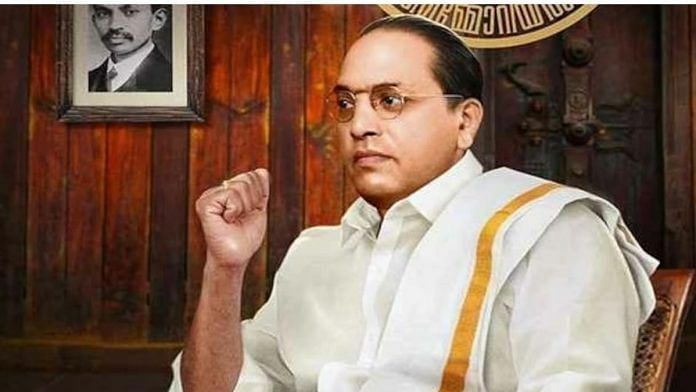When writer Unni R’s book Malayali Memorial featured Dr Bhimrao Ambedkar in an outfit associated with the ‘upper’ caste Nair community, it sparked off a debate. The white shirt, mundu and shawl with golden borders used on the cover is textbook ‘Savarna attire’. Many argued if this is appropriating Ambedkar’s identity. They questioned the limits to ‘creative’ freedom, and debated the meaning and symbolism of a particular attire to a community.
But the real question is—how far can such symbols, acquired through different historical moments, be decontextualised from community practices and memory?
Appropriating Ambedkar
Writer and activist Sunny M Kapicadu, a Dalit, raised concern over Unni’s portrayal of Ambedkar, calling it ‘Savarna invasion’. Many on social media called it a deliberate attempt to forget what a blue suit and tie meant to him.
In another incident, the Bharatiya Janata Party (BJP) installed a saffron Ambedkar statue in Uttar Pradesh’s Badaun—a visible attempt to position Ambedkar in right-wing discourse by appropriating him while erasing his trademark blue outfit.
Besides recolouring, reimagining and placing Ambedkar’s identity into misplaced ideological paradigms, his statue has also been subjected to vandalism. In fact, Ambedkar has so often oscillated between deification and condemnation that it begs the question—why is it difficult for dominant groups to accept Ambedkar as he was? The act of appropriating him as one of their own is an attempt to forget his resistance, which he asserted through his attire. It is also about not deeming Dalit bodies worthy of pedestalisation.
Also Read: ‘I’m Dalit but identify as a Brahmin’ — How Dalit comedians in India are smashing elite nexus
Decoding the trademark blue
Ambedkar is known to dress in a modern, gentlemanly way—in a neatly arranged, crisp three-piece blue suit. Unlike Gandhi’s khadi loin cloth, Ambedkar’s dress is perceived by Dalit-Bahujan community as a symbol of mobility, modernity, and respectability. Ambedkar, through his attire, wanted to connect the subaltern masses to an India where they would have access to modern institutions, education and possibilities. Even after decades, his image among the Dalit-Bahujan community is that of a moderniser with a revolutionary outlook. Emma Tarlo, in her work Clothing Matters, argues that for Ambedkar, his attire was a political statement meant to break caste barriers imposed through restrictions on clothing.
The blue colour of Ambedkar’s suit is a signifier on multiple levels. Some scholars have argued that the colour portrays Buddhist enlightenment. Some trace it back to when Ambedkar formed the Scheduled Caste Federation of India in 1942 and the Republican Party of India on 30 September 1956. The colour of his flag was blue with an Ashoka Chakra in the centre. The association of Ambedkar with blue captures the essence of his social, political and ideological struggle against an oppressive system. To the point where it has become a symbol of anti-caste movement and discourse in India.
Also Read: Seeing Ambedkar as Dalit icon is narrow. Understand his feminist vision for Indian women
The context of (mis)appropriation
The representation of Ambedkar in Unni’s book should be seen as more than a publicity stunt. It is a deliberate attempt to recast Ambedkar into moulds that deify him in a misplaced history. His praxis to stand for anti-caste ethics is strategically removed through misplaced visualisation, thereby creating public amnesia. This is not an aberration—it is deliberate systemic erasure.
But Unni says the image needs to be read in context. “The story doesn’t criticise Ambedkar; it is in fact against casteism. It is an effort made by the protagonist Santhosh to get rid of the nickname Ambedkar and get back his surname Nair. The cover page picture can be related in connection with this only….Multiplicity of voices and views is the speciality of this country. So, one should not look at this book cover with intolerance,” he told the Times of India.
Still, the choice of Ambedkar’s clothes needs to be understood more critically rather than as an oversimplified piece of fiction.
With the emergence of anti-caste consciousness, the issues of misappropriation, vilification, and misreading have also gained ground. In Ambedkar’s terminology, it can be considered as ‘counter revolution’. Activists, authors and community members must voice their concerns, and strive to uphold his legacy.
The iconisation of Ambedkar has a unique place in public discourse. Besides the symbolic reverence that he generates, the icon is also part of everyday subaltern cultural expressions, which give Ambedkarites a sense of identity and belongingness. He is regularly imagined in creative ways. But in all these methods, his blue coloured three-piece suit remains intact.
(Edited by Zoya Bhatti)






